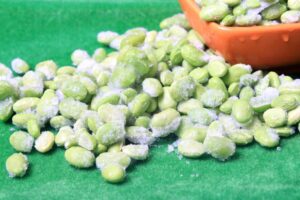Frozen Edamame: Your Guide to Cooking and Serving Tips
Frozen edamame has become a staple in many households due to its convenience and nutritional value. Packed in small pods, these young soybeans offer a protein-rich snack that appeals to vegetarians and vegans alike. Their increasing availability in the frozen section of grocery stores allows for long-term storage without sacrificing quality, making them a handy ingredient to have on hand. Japanese restaurants often serve frozen edamame as a simple appetizer, and it’s beloved for its subtle taste and versatility in various dishes.

As someone who regularly enjoys edamame, I appreciate its ease of preparation. Whether you choose to steam, boil, or microwave them, cooking edamame requires minimal effort. Toss them with seasonings like sea salt, garlic, or sesame oil for a flavorful twist. Moreover, incorporating edamame into meals provides a boost of healthy soy protein to salads, soups, and even smoothies, showcasing its adaptability in both warm and cold dishes.
Key Takeaways
- Edamame offers a protein boost ideal for plant-based diets.
- Easy preparation makes frozen edamame a convenient option.
- Edamame’s versatility spans from snacks to full meals.
Understanding Edamame
Edamame has a distinct identity within the soybean family, worth exploring through its definition, nutritional value, and varieties. It caters to a global audience with its versatility as both a fresh and frozen food product.
What Is Edamame?
I consider edamame to be the younger and greener version of the traditional soybean, often enjoyed in its pod or shelled. Harvesters pick these immature soybeans before they harden, providing a sweeter and more tender experience than mature soybeans. Because of their unique stage of harvest, between the R6 and R7 reproductive stages, they are more than just a snack; they are a delicacy that represents a specialty within the soybean family with a large pod size and vibrant green color as premium quality indicators.
Nutritional Profile
A cup of shelled edamame is a powerhouse of nutrition, consisting of about 18 grams of protein, significant fiber, and essential vitamins and minerals like vitamin K, iron, and calcium. The bean’s genotype and maturity level also influence the content of antioxidants, such as isoflavones and carotenoids, in these beans. Such nutrients make edamame a valuable addition to vegetarian and vegan diets for their plant-based protein and overall health benefits.
Varieties of Edamame
There are multiple varieties of edamame, distinguishable by their pod size, bean flavor, and color. Different types boast varying textures and tastes, suitable for a diverse array of culinary applications. Whether consumed fresh or as a frozen vegetable, they offer an enjoyable eating experience that aligns closely with consumers’ desires for health and convenience.
Selecting and Storing Edamame

In my experience, ensuring the quality and longevity of edamame begins at the point of purchase and extends to how you store it at home. I’ll share my insights on selecting the best edamame and how to store it effectively to maintain its freshness.
How to Buy Edamame
When I buy fresh edamame, I look for bright green pods that are firm to the touch. This often indicates that they are fresh and not overripe. It is important to avoid any pods that are yellowing or have spots, which could signify aging or spoilage. I always make sure to inspect the pods closely before making a purchase.
For frozen edamame, which is commonly found in the freezer aisle, I check that the packaging is intact with no signs of ice crystals or frost. These can suggest that the product has been thawed and refrozen, which can negatively impact its quality and texture.
Storing Tips for Freshness
Fresh edamame should be stored in the refrigerator soon after purchase to preserve its quality. I personally prefer to place them in the crisper drawer which offers the coolest and most consistent temperature. Here’s how I recommend storing fresh edamame:
- Refrigerator (fresh):
- Temperature: Maintain between 32°F (0°C) to 38°F (3.3°C) for optimal freshness.
- Storage method: Use a perforated plastic bag to allow for some air circulation.
- Duration: Consume within 1-2 days for the best quality.
For frozen edamame, I ensure that they are kept in the freezer immediately after I get home. Proper storage tips include:
- Freezer (frozen):
- Temperature: Keep at 0°F (-18°C) or lower to prevent spoilage.
- Storage method: Keep in its original packaging or within an airtight container.
- Shelf-life: Best used within 12 months for maximum freshness and flavor.
Preparing Edamame
When cooking edamame, it is essential to move through a few simple steps—thawing the beans if they are frozen, choosing between boiling or steaming them, and finally seasoning for enhanced flavor.
Thawing Frozen Edamame
I ensure my edamame is not frozen solid by allowing it to defrost slightly before cooking. This can be done by leaving the beans at room temperature for a few hours or using a microwave for a quick defrost cycle. Proper thawing is crucial to maintain edamame’s texture.
Boiling and Steaming Methods
Boiling entails bringing a pot of salted water to a boil, then adding the edamame and cooking them for about five minutes. I always remind myself not to overcook edamame to prevent them from turning mushy. On the other hand, steaming is gentler—setting the edamame in a steamer basket over boiling water for roughly the same amount of time. Once done, I promptly drain the edamame to stop the cooking process.
Seasoning and Serving Ideas
Seasoning is where edamame really shines. After boiling or steaming, I toss the pods with salt and other favorite seasonings, such as crushed garlic or chili flakes, ensuring the beans are well-coated and flavorful. Besides salt, edamame can benefit from various flavors, which incorporate beautifully when the pods are warm and just cooked.
The different techniques used to cook edamame can impact their nutritional profile and flavor, which is highlighted in a study on the Effect of different drying techniques on edamame. This is something I keep in mind when deciding on my cooking method.
Integrating Edamame Into Meals
I find that edamame is a versatile ingredient that can enrich various meals with both its protein content and crisp texture. It fits effortlessly into a balanced diet, be it for those following vegan and vegetarian principles or for individuals seeking healthy meal options.
Salads and Appetizers
- Salad Enhancement: Adding shelled edamame to a salad boosts its protein content and provides a satisfying crunch. It pairs wonderfully with leafy greens and a tangy vinaigrette.
- Creative Appetizers: Edamame works as a vibrant appetizer, either on its own with a sprinkle of sea salt or incorporated into dishes like avocado edamame hummus.
Main Dishes and Sides
- Protein-Packed Mains: Incorporating edamame into vegan or vegetarian main dishes, such as edamame-studded fried rice or entwined in noodles with a savory sauce, is a delightful way to up the protein.
- Sides: Whether it’s mixed into a quinoa salad or served as a simple side dish, edamame complements many proteins like salmon or tofu.
Snacks and Quick Bites
- Healthy Snacking: For a quick and healthy snack, simply steam edamame and season with sea salt; it’s an effortless way to satisfy hunger pangs.
- On-the-go Nourishment: Edamame can be added to trail mix or blended into a smoothie for a nutrient boost when you’re in need of a swift, wholesome bite.
Recipe Inspirations
When I look at a bag of frozen edamame, I see countless opportunities for creative and satisfying dishes. They can range from simple snacks that highlight the natural flavor of edamame to innovative meals that incorporate them into more complex recipes.
Simple Edamame Snack Recipes
My go-to snack is a healthy serving of frozen edamame pods, lightly steamed or microwaved until warm. To garnish, I sprinkle with sea salt and sometimes a bit of toasted sesame seeds for added texture and flavor. This is a method I found to be both satisfying and nourishing.
For an even richer taste, I sometimes prepare a zesty lemon-garlic hummus dip. Here’s how:
- Puree chickpeas with garlic, lemon juice, olive oil, and a pinch of salt.
- Blend in a handful of thawed frozen shelled edamame for an extra protein kick.
- Serve with whole edamame pods to scoop up the hummus.
Innovative Edamame Dishes
Broadening my culinary horizons, I’ve incorporated edamame into various main courses. A favorite is making a vibrant poke bowl where I include edamame as a key ingredient alongside fresh fish, rice, and vegetables, drizzled with a soy sauce-based dressing.
Another creative way to use edamame is in a stir-fry. I love the following simple steps for a quick dinner:
- Sauté your choice of meats or tofu with a mix of colorful veggies.
- Add thawed edamame towards the end to keep them crisp.
- Splash with soy sauce, add a hint of garlic, and serve over rice or noodles.
Frequently Asked Questions

In this section, I address common inquiries about frozen edamame, covering preparation methods, recipes, purchase locations, nutritional content, and consumption safety.
How do you prepare frozen edamame in the microwave?
To prepare frozen edamame in the microwave, simply place the edamame in a microwave-safe bowl, add a bit of water, and cover the bowl with a plate. Microwave on high for a few minutes, until edamame are heated through. For exact instructions, it’s best to refer to the packaging or check out methods like microwaving frozen edamame.
What are some healthy recipes that include frozen edamame?
Frozen edamame is versatile in recipes, such as salads, stir-fries, and grain bowls. Including edamame adds protein and fiber to your meals. You can find inspiration for recipes that incorporate edamame like edamame salads.
Where can I purchase frozen edamame?
Frozen edamame can be found in most grocery stores, typically in the frozen vegetables section. They are sometimes available in organic varieties as well.
What is the nutritional value of frozen edamame?
Frozen edamame is rich in protein, fiber, and essential vitamins and minerals. One cup of cooked edamame provides around 17 grams of protein and 8 grams of fiber. More detailed nutritional information can be found on sites focused on the nutritional aspects of edamame.
Can you consume frozen edamame without cooking it?
No, I recommend against eating frozen edamame without cooking it. Cooking ensures the edamame are safe to eat and more digestible. Plus, it enhances the flavor.
Does the taste of frozen edamame differ from fresh?
The taste of frozen edamame is very similar to fresh when cooked properly. However, some may find that fresh edamame has a slightly better texture and a fresher flavor.


 Previous Post
Previous Post Next Post
Next Post